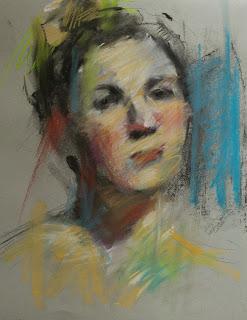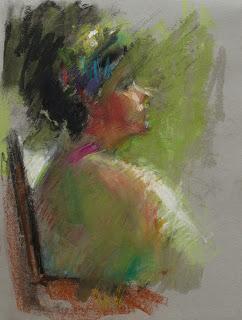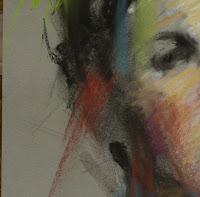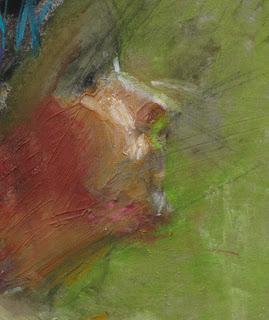
D in Lines
14 x 11

D in profile
14 x 11
Last week I took some really old (let's just call them "vintage") Grumbacher chalk pastels to figure drop in. I haven't thrown out an art supply in my life, so these pastels have been with me since I was 13. They're as hard as rock - similar to a 2B pencil - limited in colours, and devoid of character, but they were still wonderful fun to mix with other mediums, and the sheer force needed to apply them means that using them is a vigorous, full arm endeavour. These drawings contain vine charcoal, soft pastels in black and white, and, in the profile picture, an oil bar used as a blender.
Starting with charcoal, I mapped out the many angles of the face lightly and with the longest projecting lines that I could. By extending lines across the page, I can find relationships within the form. So there was a long line that went from the top of the eyebrow to the top of the ear, and a line extending from the jaw across the top of the shoulder. I put the lines in first, not the eyebrows, ears and jaw. Finding these big lines that connect one element to another means that I avoid the common pitfalls of poor proportion that could happen if I worked from one feature and shape to the next. They act as a large framework on which I can locate smaller elements like features and bone structure. And they look interesting, creating a web of line work that can either be preserved in the final drawing or obscured completely. You can see traces of them in the details of both of these pieces.

Construction lines showing angles of brow and jaw

Construction lines for each important element: brow, nose, mouth, jaw. These are connected to other elements at the back of the head and upper back. This also shows the waxy blender in action.
Then it was a matter of stating, and restating shapes which is exactly how I work in paint. I start with a tentative notation of size and placement, and, as I put more small notes on, I begin to see which marks are true and which need moving. Starting out light and tentative means that I can continue to move big shapes around with impunity, knowing that I can cover my tracks later on with stronger statements, or leave them as a sign of where I've been; signs of my struggle to depict what was in front of me. The frontal portrait took about 2 1/2 hours and, by the time I was adding colours, I knew where everything should be, so I could approach this stage with great freedom, scribbling in, and over features with the knowledge that I could regain them by referring to the many lines and connected elements in the rest of the drawing.
Each of these drawings was restated numerous times and, in between, I scraped, smudged, and redrew repeatedly. There was no erasing, as that stops the flow and joy of "make a mark and respond to that mark" that makes working into a playful dance.
The oil bar blender is something that I'll use again because it builds a painterly, waxy surface to scratch back into and move around. It's difficult to get hard pastels to adhere on top of it, but the soft white pastel had less trouble with it, and I could put some color on top of that, creating a painting of sorts. I also used an old bulldog clip to scrape wax and color down when it got too thick, blending marks and allowing me to put more pigment on top.
A change is as good as a rest, and I enjoyed this change in routine.
Happy painting!

